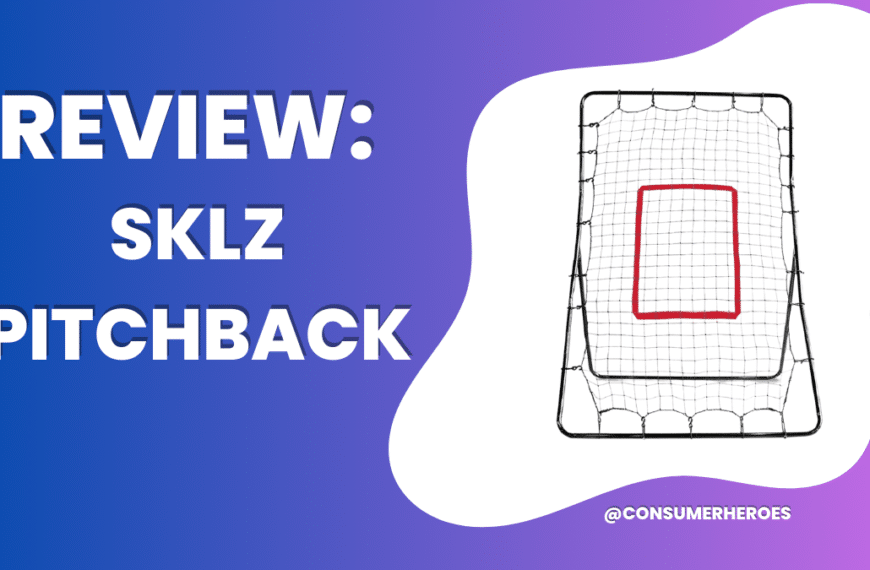Looking for a way to improve your baseball skills? A baseball rebounder can be a great tool to help you practice your catching, throwing, and hitting. Instead of relying on a partner or coach, you can practice on your own and improve your skills at your own pace.
While you can buy a baseball rebounder, making your own can be a more affordable and customizable option. With a few simple materials and some basic tools, you can create a rebounder that meets your specific needs and helps you achieve your baseball goals. In this article, we’ll walk you through the steps to make your own baseball rebounder and offer tips for getting the most out of your practice sessions.
So, whether you’re a beginner looking to improve your skills or an experienced player hoping to take your game to the next level, making your own baseball rebounder can be a fun and rewarding project. With a little time and effort, you’ll have a tool that can help you hone your skills and become a better player.
Understanding Baseball Rebounders
Purpose of a Baseball Rebounder
A baseball rebounder is a training tool that helps players improve their skills by providing a way to practice throwing, catching, and hitting without needing a partner. It is a versatile piece of equipment that can be used for a variety of different drills and exercises.
One of the main benefits of using a rebounder is that it allows you to practice your skills on your own time, without needing someone else to be there with you. This can be especially helpful for players who have busy schedules or who don’t have access to a regular practice partner.
Another benefit of using a rebounder is that it can help you improve your reaction time and hand-eye coordination. By practicing with a rebounder, you can get more repetitions in a shorter amount of time, which can help you develop your skills more quickly.
Different Types of Baseball Rebounders
There are several different types of baseball rebounders available, each with their own unique features and benefits. Some of the most common types include:
- Pitchback Rebounders: These are the most basic type of rebounder, and are designed to be used for throwing and catching practice. They typically consist of a net that is attached to a frame, and can be adjusted to different angles to simulate different types of throws.
- Hitting Rebounders: These rebounders are designed specifically for hitting practice. They typically have a larger surface area than pitchback rebounders, and are made from materials that can withstand repeated impact from baseballs.
- Multi-Sport Rebounders: These rebounders are designed to be used for multiple sports, including baseball, soccer, lacrosse, and more. They typically have adjustable angles and can be used for a variety of different drills and exercises.
When choosing a baseball rebounder, it’s important to consider your specific needs and goals. Think about what types of skills you want to improve, and choose a rebounder that is designed to help you achieve those goals.
Materials Needed
If you are looking to make a baseball rebounder, there are a few materials you will need to get started. In this section, we will go over the essential materials you will need to make a high-quality rebounder.
Choosing the Right Wood
The first thing you will need to consider is the type of wood you will use to build your rebounder. The most commonly used wood for this type of project is plywood. However, not all plywood is created equal. You will want to make sure that you choose a high-quality plywood that is at least 1/2 inch thick. This will ensure that your rebounder is sturdy and can withstand the force of a baseball hitting it.
Selecting the Net
The next essential material you will need is the netting. You will want to choose a netting material that is strong enough to withstand the force of a baseball hitting it repeatedly. The most commonly used netting for this type of project is nylon. Nylon netting is strong, durable, and can withstand the elements.
Other Essential Tools
In addition to the wood and netting, you will need a few other essential tools to complete your rebounder. These tools include:
- Saw
- Drill
- Screws
- Hammer
- Nails
- Measuring tape
You may also want to consider using a staple gun to attach the netting to the wood. This will ensure that the netting is securely attached and will not come loose over time.
Overall, making a baseball rebounder is a fun and rewarding project that can be completed with just a few essential materials. By choosing the right wood, selecting the right netting, and using the proper tools, you can create a high-quality rebounder that will provide hours of entertainment and practice for you and your family.
Building the Frame
Measuring and Cutting the Wood
To build a baseball rebounder, you will need to start by building the frame. The frame is what holds the netting in place and allows the ball to rebound back to you. To build the frame, you will need to measure and cut the wood according to the following specifications:
- 2 pieces of 2x4x8 lumber
- 2 pieces of 2x4x6 lumber
- 4 pieces of 2x4x4 lumber
- 4 pieces of 1x4x8 lumber
Start by measuring and cutting the 2x4x8 lumber into two 6-foot lengths. Then, measure and cut the 2x4x6 lumber into two 4-foot lengths. Finally, measure and cut the 2x4x4 lumber into four 3-foot lengths.
Assembling the Frame
Once you have cut the wood to size, it’s time to assemble the frame. Follow these steps to assemble the frame:
- Lay the two 6-foot 2x4s parallel to each other on the ground, with the 4-foot 2x4s perpendicular to them at each end. This will create a rectangle shape.
- Attach the 4-foot 2x4s to the 6-foot 2x4s using wood screws. Make sure to pre-drill the holes to avoid splitting the wood.
- Attach the 3-foot 2x4s to the inside corners of the rectangle using wood screws. These will act as braces to reinforce the frame.
- Finally, attach the 1x4x8 lumber to the top of the frame using wood screws. This will create a ledge for the netting to rest on.
Congratulations! You have now built the frame for your baseball rebounder.
Attaching the Net
Attaching the net to the frame is an important step in making your baseball rebounder. This section will guide you through the process of attaching the net to the frame.
Cutting the Net to Size
Before attaching the net, you need to cut it to the right size. Measure the length and width of the frame and add a few inches to each measurement. This will give you enough material to wrap around the frame and secure it in place.
Use a pair of sharp scissors or a utility knife to cut the net to the desired size. Make sure to cut it straight and even, as this will make it easier to attach to the frame.
Securing the Net to the Frame
Once you have the net cut to size, it’s time to attach it to the frame. Start by laying the net over the frame, making sure that it is centered and evenly distributed.
Next, use zip ties or twine to secure the net to the frame. Start at one corner and work your way around the frame, pulling the net tight as you go. Make sure to secure the net at regular intervals, about 6-8 inches apart, to prevent it from sagging or coming loose.
As you secure the net, make sure to check that it is still centered and evenly distributed. Adjust the tension as needed to ensure that the net is taut and ready to rebound the baseball.
In conclusion, attaching the net to the frame is an important step in making your baseball rebounder. Make sure to cut the net to size and secure it tightly to the frame to ensure that it is effective and long-lasting.
Final Touches
Now that you have completed building your baseball rebounder, it’s time to add some final touches to ensure that it is safe to use and will last for a long time. Here are some important things to keep in mind:
Safety Precautions
When using your baseball rebounder, safety should always be a top priority. Here are some safety precautions to keep in mind:
- Always wear appropriate protective gear, including a helmet and gloves, when using the rebounder.
- Make sure the rebounder is securely anchored to the ground before use to prevent it from tipping over.
- Keep the rebounder away from any obstacles or hazards that could cause injury.
- Never stand directly in front of the rebounder when throwing the ball.
- Always supervise children when using the rebounder.
Maintenance Tips
Proper maintenance is essential to keep your baseball rebounder in good condition. Here are some tips to help you maintain your rebounder:
- Regularly inspect the rebounder for any signs of wear and tear, such as frayed netting or damaged frame components. Replace any damaged parts immediately.
- Clean the rebounder regularly with a mild soap and water solution to remove dirt and debris.
- Store the rebounder in a dry, sheltered area when not in use to protect it from the elements.
- Lubricate any moving parts, such as hinges and bolts, to prevent rust and corrosion.
- Check the tension of the netting regularly to ensure that it is taut and properly secured to the frame.
By following these safety precautions and maintenance tips, you can ensure that your baseball rebounder is safe to use and will last for many years to come.
Conclusion
Congratulations! You have successfully built your own baseball rebounder. With a little bit of effort and some basic tools, you can now have a great training tool to help you improve your baseball skills.
Remember, the rebounder is a versatile piece of equipment that can be used for a variety of drills. It can help you improve your catching, fielding, throwing, and hitting skills. You can use it to practice alone or with a partner.
Making a baseball rebounder is a fun and rewarding project that can be done by anyone, regardless of skill level. Plus, it’s a great way to save money compared to buying one from a store.
If you have any questions or need further guidance, don’t hesitate to reach out to a professional or experienced builder. They can provide you with additional tips and tricks to help you get the most out of your rebounder.
So, what are you waiting for? Grab your tools and get started on building your own baseball rebounder today!
Frequently Asked Questions
What materials do I need to make a baseball rebounder?
To make a baseball rebounder, you will need the following materials:
- Plywood board
- Bungee cords
- Eye bolts
- Carabiners
- Tennis ball
You can find these materials at your local hardware store or online.
How can I make a baseball rebounder that is portable?
To make a portable baseball rebounder, you can attach wheels to the bottom of the plywood board. This will make it easier to move around and transport to different locations.
Are there any DIY plans available for making a baseball rebounder?
Yes, there are many DIY plans available online for making a baseball rebounder. You can find step-by-step instructions and videos that will guide you through the process.
What are some tips for building a durable and long-lasting baseball rebounder?
To build a durable and long-lasting baseball rebounder, make sure to use high-quality materials and follow the instructions carefully. It’s also important to regularly check and tighten the bungee cords to ensure they are secure.
Can a baseball rebounder be used for practicing other sports?
Yes, a baseball rebounder can be used for practicing other sports such as soccer, lacrosse, and hockey. Simply adjust the tension of the bungee cords to match the sport you are practicing.
How do I adjust the tension on a homemade baseball rebounder?
To adjust the tension on a homemade baseball rebounder, simply adjust the length of the bungee cords. Shorter cords will create more tension and a stronger rebound, while longer cords will create less tension and a weaker rebound.







